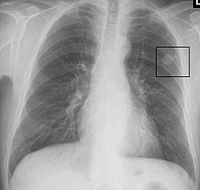
Photo from wikipedia
Background: Despite recent advances in guided bronchoscopy, the yield of bronchoscopic biopsy of a peripheral pulmonary nodule (PPN) remains highly variable. Objective: The aim of the study was to evaluate… Click to show full abstract
Background: Despite recent advances in guided bronchoscopy, the yield of bronchoscopic biopsy of a peripheral pulmonary nodule (PPN) remains highly variable. Objective: The aim of the study was to evaluate which features of robotic assisted bronchoscopy (RAB) contribute to a successful biopsy in a cadaver model. Methods: A preclinical, prospective, single-blinded trial using a ventilated human cadaveric model assessed the successful puncture of implanted pulmonary nodules using various localization techniques with RAB. The different approaches included positioning the robotic catheter at predefined distances from the target nodule (<10 mm, 10–20 mm, 20–30 mm), bronchoscopist correction of divergence between the software virtual map and bronchoscopic view if observed, and impact of fluoroscopy and radial endobronchial ultrasound (rEBUS). The primary endpoint was a central target hit (defined as an inner 2/3 target puncture) verified by cone-beam computed tomography. Results: Thirty-eight RAB procedures were performed to target 16 PPNs. Median nodule size was 16.2 mm. All targets were located in the outer 1/3 of the lung with a bronchus sign in 31.3%. Central target hit rates were improved when the robotic catheter tip was closer to the nodule (<10 mm 68%, 10–20 mm 66%, 20–30 mm 11%, p < 0.001). Multivariable analysis confirmed the strongest predictor of a central target hit was robotic catheter distance to nodule (OR 0.89 per increase in 1 mm, p < 0.001), independent of the presence of a bronchus sign, divergence or concentric rEBUS view. Conclusions: Utilizing a RAB platform, closer proximity of the robotic catheter to the target nodule results in an increase in peripheral nodule biopsy success.
Journal Title: Respiration
Year Published: 2022
Link to full text (if available)
Share on Social Media: Sign Up to like & get
recommendations!